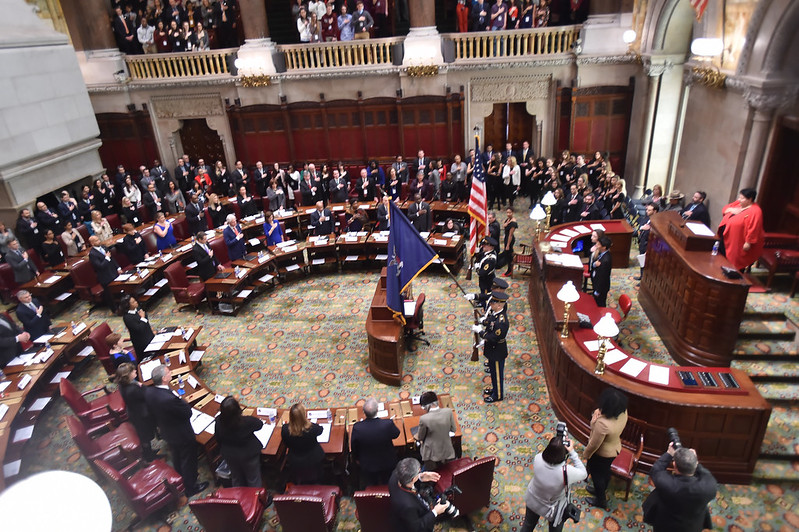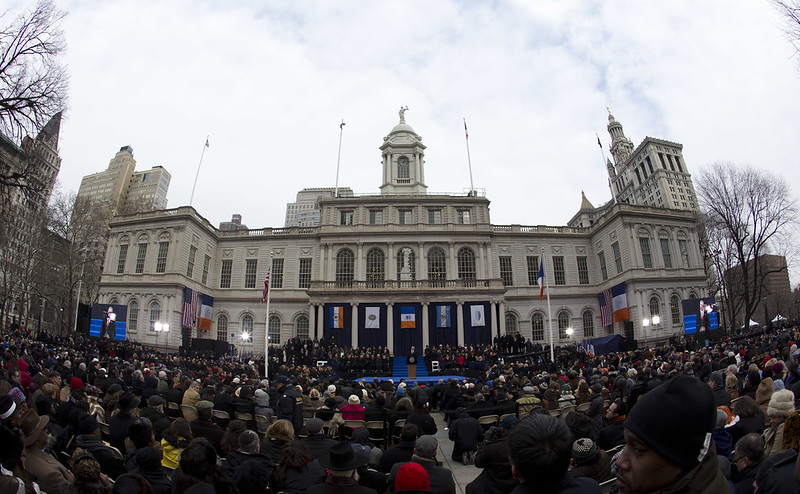A Redistricting Power Grab

Inside the State Senate chamber (photo: Kevin P. Coughlin/Governor's Office)
The New York State Senate and Assembly, both now in Democratic hands, last month gave first passage to several changes to an earlier constitutional amendment, adopted in 2014, creating a so-called Independent Redistricting Commission to redraw district lines every ten years for those two houses and the state’s Congressional districts. If passed by the Legislature again next year, and then approved by the voters, these amendments to that earlier amendment will go into effect in time to be used for the drawing of district lines in 2022. That would mean that the version approved by the voters in 2014 would never be used. Every one of the 40 Democrats in the state Senate voted for these changes. In the Assembly 91 of the 101 Democrats were in favor — while nine members, all from outside New York City, voted against.
Truth be told, I was not a big fan when we New Yorkers voted to place the so-called Independent Redistricting Commission in the state constitution in 2014. I say “so called’ because there was nothing independent about the commission. Eight of its ten members, two each, were appointed by the majority and minority leadership of the Assembly and Senate, and the commission’s recommendations went back to the two houses for adoption. If they failed to pass, the Legislature retained the final authority to do the job itself.
In my view, self-interested politicians should not decide on any of the conditions or rules under which they are elected or reelected. Truly fair redistricting, I thought then and think now, requires the final decision on district lines to be made by persons who meet two basic criteria: they are not seeking election in those districts and are not beholden to anyone who is.
For decades, divided partisan control of the state Legislature produced New York’s infamous bi-partisan gerrymander. Republicans controlled drawing the lines for the Senate, Democrats for the Assembly, and then they voted for each other’s plans. The so-called Independent Redistricting Commission amendment was a response to reformers’ pressure to do something about this. It was the appearance of action masking the absence of real change, accepted by some as “a good first step.”
The 2020 proposed constitutional amendments if adopted will bring a welcome end to two practices long used by Republicans to retain Senate control: Increasing the number of seats in the body and counting downstaters imprisoned in GOP-dominated upstate rural areas - and not allowed to vote - as residents there, beefing up their population, and therefore their legislative representation. If the amendments pass the size of the Senate will be fixed at 63 members and the provision of a previously passed statute will be constitutionalized, to assure re-enumerat[ion] of incarcerated persons..[at] their place of last residence for the purposes of drawing district lines.”
Less savory, other changes first passed this July would undo two provisions of the original 2014 amendment designed to protect the interests of the minority parties in both houses (at that time the Republicans in the Assembly and the Democrats in the Senate). These are the alternative voting rules specified for the commission to recommend a redistricting plan, and the two houses to approve its recommendations, under alternative partisan circumstances in the Legislature.
To send a plan to the Legislature a redistricting commission now requires seven votes, including that of at least one of the two appointees of each of the four legislative leaders. (This explicitly specifies the mathematical consequence of requiring a supermajority of 7 in a group of 10 members to act, when each of four leaders appoints two commission members.) This provision protected the minority parties in each house, not always previously looked after by their co-partisans when deals were reached between the two majorities. It was also an insurance policy for the then-precarious, now-vanquished, Republican majority in the Senate.
In the 2020 proposed amendment, just given first passage, the seven-person super-majority has been kept, but the requirement that at least one of these be chosen by each appointing authority has been removed.
The size of the majority in both houses required to pass a commission-recommended plan under the provision in place differs, based upon whether control of the legislature is divided or in one party’s hands. If divided control (the case when the original amendment was passed) a simple majority is needed in each house. If one party controlled both houses (the case now) two-thirds in each house is required.
Then as now Assembly Democrats held more than two-thirds of the seats in that body. The Senate, however, was closely divided in 2014. This supermajority requirement potentially empowered the Senate Democrats in the redistricting process to a greater degree than before. It also preserved leverage for Republicans if they lost control of the Senate, as then appeared inevitable and has, of course, since occurred.
Finally, what if deadlock occurred in the commission? (Not an unlikely eventuality, if experience is any guide.) The commission was then to send its most supported option or options to the Legislature, where an affirmative vote of 60% in each house would be needed to pass one of these plans, or an alternative.
The changes passed this year make the required majority 60%, both if the two houses of the Legislature are in the hands of a single party or the commission is deadlocked. They also make it explicit that, absent a commission recommendation, the Legislature may adopt a plan of its own devising.
Democrats now hold 40 of 63 Senate seats (63.5%), enough to control the outcome of redistricting under the new revisions in all partisan circumstances, but not enough if there is deadlock on the commission under the unrevised rules. Hence, assuming they can retain this size majority this November, or grow it, and the proposed constitutional amendments gain the required second passage and voter approval, redistricting next year and the year after will be more firmly in the hands of the Democratic majorities in both houses.
The complexity is admittedly a bit mind-boggling, but it comes down to this: The Democratic majority members in the state Legislature – many of whom are self-declared champions of political reform – want to alter a constitutional provision passed to achieve independent legislative districting before it has ever been used, giving themselves greater control of the process. Ironically, the untested provision itself almost certainly achieved only the illusion of reform. Also ironic, given New York’s politics and demographics, there is no chance that districts can be created that will place Democratic control of both houses at risk in the years ahead. With their current ample majorities, Assembly and Senate Democrats could advance real independence in drawing district lines for themselves and for Congress with little or no political risk. But instead they have chosen to preserve the illusion of reform, while further empowering themselves to act in their own self-interest. Maybe Plunkett of Tammany Hall was right after all: “Reformers are only morning glories,” at least on some mornings in July.
***
Gerald Benjamin is Emeritus Founding Director of The Benjamin Center at SUNY New Paltz.
***
Have an op-ed idea or submission for Gotham Gazette? Email This email address is being protected from spambots. You need JavaScript enabled to view it.
Prosecutors Need To Go After Developer Zoning Fraud

Time to crack down on zoning fraud, the author argues (photo: mayor's office)
Most of the world now knows the Kushner name for the widespread political corruption of the Trump administration, but the family company has been ripping off New Yorkers for years. How did a slumlord developer get all the way to the White House?
Fittingly the answer lies with the President’s lawyer, Rudy Giuliani, who paved the way as Mayor of New York City by shifting enforcement of vital building regulations to an honor system. But an honor system only works when there are true consequences for violating it. Enforcement has been tepid at best, emboldening bad actors to falsify plans to build structures that violate zoning and other building codes with impunity, thereby lining their pockets with millions of dollars in ill-gotten gains. The solution is to stop defaulting to civil regulation and start criminally investigating professionals and entities who file false statements.
The problem stems from the unpoliced self-certification program.
Given the fast pace of development, the New York City Department of Buildings (DOB) doesn’t review every plan, and regulators don’t necessarily have the bandwidth to scour for falsehoods. Under Giuliani, the city expanded the abilities of licensed architects and engineers to attest to the DOB and other relevant agencies that a project complies with the law. The thinking was that these design professionals were licensed by the city and state and therefore could be trusted to always tell the truth. This ignored the obvious conflict; their livelihoods were dependent on the very developers who stood to profit from violating zoning protections.
On the rare occasion that authorities find a false statement, the punishment is a lowly fine, like the $210,000 in the Kushner case, even though under New York law it’s a felony to submit false paperwork and each false document carries a term of imprisonment of up to four years. The complete lack of oversight allowed the Kushners to harass and eventually chase out long-time tenants from the East Village and the Lower East Side to make way for wealthy, market-rate tenants.
As the former head of the Manhattan District Attorney’s Construction Fraud Taskforce, I’ve fought rampant, unchecked self-certification. More than a decade ago, it was key to convicting executives who falsified the concrete strength of iconic New York City landmarks like the World Trade Center, Yankee Stadium, and Second Avenue Subway. More recent examples include 1059 Third Avenue and 249 East 62nd Street, aka the “condo on stilts.” At 62nd Street, the building’s mechanical void — unoccupied floor spaces usually created to help structural integrity — raised concerns about the added height and sturdiness of the building. Turns out that the architect had filed one set of plans with the fire department, and another with DOB. And after community groups and the Manhattan Borough President complained about irregularities with the mega-project on Third Avenue, which exposed similar false claims, the developers changed the plans. That’s good, but it’s not enough. It shouldn’t be up to ordinary New Yorkers to enforce our laws, that’s the role of the District Attorney.
We need a strong city with good housing, schools, hospitals, and public spaces — not just shaky glass towers filled with pied-à-terres. Developers have long competed in a race to the top by shirking necessary regulations. It’s time for prosecutors to finally pay attention to the fraud building up in front of their faces and that is killing the economic prosperity of our residents and the city. Without consistent criminal enforcement fraud will continue to be a risk worth taking.
***
Diana Florence is a candidate for Manhattan District Attorney and the former head of the Manhattan DA’s Construction Fraud Task Force. On Twitter @DianaJFlorence.
***
Have an op-ed idea or submission for Gotham Gazette? Email This email address is being protected from spambots. You need JavaScript enabled to view it.
Seeking the Next Generation of Public Servants

New York City Hall (photo: mayor's office)
There is no question that today’s young people demand more from those in power and seek to correct broken systems. The recent wave of protests, petitions, and activism following the murders of George Floyd, Breonna Taylor, and other Black Americans at the hands of the police brought front and center a change-making generation that refuses to stay silent against horrific injustices. We are outraged and reacting in the most effective ways we know how.
Our efforts have made many strides: catalyzing policing reforms, toppling Confederate statues, and thrusting accountability onto lawmakers to make our cities better. As our frustrations in this nation have grown, and as I reflect on my own family experiences, I want to encourage more young people to pursue careers in government.
My grandmother would often tell me the story about how her father rebelled against a cruel British overseer in then-colonial British Guiana. She described my great-grandfather’s courage and commitment to change that resulted in him being evicted from his home and blacklisted from work in neighboring villages. My grandmother, on the other hand, honored her father’s legacy of rebellion in a different way. What she did, and her recommendation for visionary young people who wish to effect change in their society, was to join the civil service.
As I’ve learned from my family and come to believe for myself, change can truly be made from within. The Guyanese people did not get real justice in the country they built until a wave of young Guyanese citizens, like my grandmother, joined the civil service and ultimately effected policy that dismantled the country’s slavery-akin labor laws. The same will be true in the United States. More forward-thinking young people working in and leading the public sector will lead to more effective change -- but we must be determined to make this reality.
That’s the work I have set out to do, while encouraging other members of my generation to join me. I’m currently a student at the Sophie Davis School of Biomedical Education/CUNY School of Medicine. Last November, I won the Paul A. Volcker Careers in Government Essay Contest, a competition led by the Volcker Alliance aimed at encouraging students to pursue careers in public service. For the past three years, I’ve worked part-time at the New York City Department of Health and Mental Hygiene. Witnessing the impact of the work I’ve done in New York City local government, even as a college student, has reinforced my commitment to public service. Government can be judged based on how it mobilizes for the most vulnerable and how it reacts to crises. Now more than ever, our country deserves effective leadership.
The good news is that we have a generation of young people that can bring a wealth of knowledge and influence to the public sector. We are technologically-savvy. We are curious and inquisitive. We are respectful of cultural differences and tolerant of divergent viewpoints. We are resilient. We are advocates. We are many colors. Change cannot happen until public leadership reflects the people it serves.
I urge you to consider pursuing a career in government. Helpful tips I’ve learned along the way that can help you get started include:
- Find a cause that you are passionate about.
- Research your cause, keeping in mind there is likely a public sector job related to this cause that will help you advance change.
- Search for government internships and jobs around your college and online, and/or join organizations that support those interests.
- Advocate and protest on as many fronts as you can.
In New York City, you can search for positions in city government by area of interest. If you want to look far and wide, check out governmentjobs.com to see opportunities all across the country at once. If you’re trying to discern whether government is the right fit for you, another great option is paid fellowship programs like the Presidential Management Fellowship in federal service, Govern for America with states, Lead for America with underserved localities, or Coding it Forward for tech workers. You don’t have to be a policy or government major. The expertise that the government needs is wide-ranging.
As my frustrations with those in power have grown, I’ve reflected on the words of fellow Caribbean-American and personal hero, the late Congressional Rep. Shirley Chisholm, who once said, “You don’t make progress by standing on the sidelines…You make progress by implementing ideas.” As we all strive to embody the change that we seek, I believe that we can all be inspired by the lessons from my grandmother, from Rep. Chisholm, and from many others to utilize our defiance and take our abilities to the highest levels of impact through work in the public sector.
Join me.
***
Arslan Mohamed is a student at the Sophie Davis School of Biomedical Education/CUNY School of Medicine and winner of the 2019 Paul A. Volcker Careers in Government Essay Contest.
***
Have an op-ed idea or submission for Gotham Gazette? Email This email address is being protected from spambots. You need JavaScript enabled to view it.




